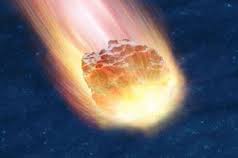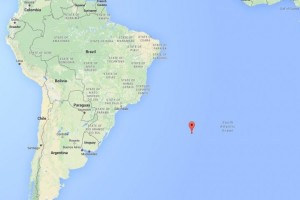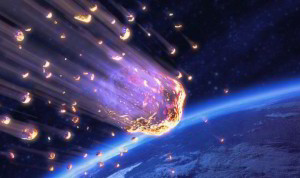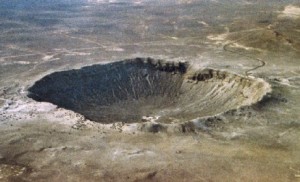Meteor Explodes with More Force than the Hiroshima Bomb : A Well Thought Out Scream by James Riordan

 On February 6th, a meteor exploded over the Atlantic with more force than the atomic bomb dropped on Hiroshima to end World War II. Usually, when a meteor enters out atmosphere it starts burning immediately and is disintegrated well before it hits the ground. Sometimes the meteor is so large that it still makes an impact. Scientists believe that it was a large meteor impact that created the first Ice Age and we know from a plethora of sci-fi movies that a big enough meteor or asteroid could destroy our entire planet. And we’re not talking moon-sized or anything nearly that big to do the job. A football field sized rock would accomplish the same thing because of the impact. This is not likely to ever happen, but it is likely enough that there are teams of scientists working righ now of way to detect such a menace and destroy it or divert it well before it reaches the earth. Personally, I figure that as long as Bruce Willis is around, we’ll be okay. And I’d take Will Smith as well based on the number of time he has saved the world on celluloid.
On February 6th, a meteor exploded over the Atlantic with more force than the atomic bomb dropped on Hiroshima to end World War II. Usually, when a meteor enters out atmosphere it starts burning immediately and is disintegrated well before it hits the ground. Sometimes the meteor is so large that it still makes an impact. Scientists believe that it was a large meteor impact that created the first Ice Age and we know from a plethora of sci-fi movies that a big enough meteor or asteroid could destroy our entire planet. And we’re not talking moon-sized or anything nearly that big to do the job. A football field sized rock would accomplish the same thing because of the impact. This is not likely to ever happen, but it is likely enough that there are teams of scientists working righ now of way to detect such a menace and destroy it or divert it well before it reaches the earth. Personally, I figure that as long as Bruce Willis is around, we’ll be okay. And I’d take Will Smith as well based on the number of time he has saved the world on celluloid.
 Meteoroids come in a very large range of sizes, from specks of dust to many-kilometer-wide boulders. A little over a year ago a big one hit in Russia. Residents of Russia’s Chelyabinsk region were shocked by a giant fireball streaking across the sky. The explosion, caused by a small meteoroid entering the atmosphere, reportedly injured hundreds as it blew out windows and sent glass flying. Dozens of videos of the meteor trail and its aftermath quickly appeared online, and analyses of these eyewitness accounts as well as measurements from scientific instruments are giving scientists one of the best looks ever at an atmospheric meteor burst. NASA determined that the Chelyabinsk meteor was the largest meteor since the Tunguska event in 1908, which flattened hundreds of acres of remote forest in Siberia. They believe the meteor was about 50 feet (15 meters) across before it entered Earth’s atmosphere. That’s significantly smaller than Tunguska, which is believed to have been about 130 feet (40 m) in diameter. [See Images of the Russian Meteor Explosion]
Meteoroids come in a very large range of sizes, from specks of dust to many-kilometer-wide boulders. A little over a year ago a big one hit in Russia. Residents of Russia’s Chelyabinsk region were shocked by a giant fireball streaking across the sky. The explosion, caused by a small meteoroid entering the atmosphere, reportedly injured hundreds as it blew out windows and sent glass flying. Dozens of videos of the meteor trail and its aftermath quickly appeared online, and analyses of these eyewitness accounts as well as measurements from scientific instruments are giving scientists one of the best looks ever at an atmospheric meteor burst. NASA determined that the Chelyabinsk meteor was the largest meteor since the Tunguska event in 1908, which flattened hundreds of acres of remote forest in Siberia. They believe the meteor was about 50 feet (15 meters) across before it entered Earth’s atmosphere. That’s significantly smaller than Tunguska, which is believed to have been about 130 feet (40 m) in diameter. [See Images of the Russian Meteor Explosion]
Though the details are argued endlessly by those who study such phenomena (it is very hard to get good data when you don’t know when/where the next meteor will occur), the following qualitative description gets much of the important ideas across. The basic idea is that the enormous entry velocity into the atmosphere (on the order of 15 km/s15 km/s for the great many readers out
there who can understand this kind of math — all five of you including my friend
Gene Kellogg) places the object under quite a lot of stress. The headwind places a very large pressure in front of it, with comparatively little pressure behind or to the sides. If the pressure builds up too much, the meteor will fragment, with pieces distributing themselves laterally. This is known as the “pancake effect.”
As a result, the collection of smaller pieces has a larger front-facing surface area, causing even more stresses to build up. In very short order, a runaway fragmentation cascade disintegrates the meteor, depositing much of its kinetic energy into the air all at once.
On February 6th the folks who detect atmospheric explosions for the United States government noticed something a bit out of the ordinary off the coast of Brazil. At roughly 2 p.m. UTC, a wayward meteor measuring roughly the size of a small living room entered Earth’s atmosphere and — while traveling over 34,000 miles per hour — exploded with an incredible amount of force. How much force, you ask? Think 13,000 tons of exploding trinitrotoluene (TNT), or more energy than what was given off by the atomic bomb detonated over Hiroshima.
According to recent data released by NASA’s Near Earth Object Program, the meteor was located some 1,150 miles southeast of the Brazilian city of Rio de Janeiro, essentially in the middle of the Atlantic Ocean. As it careened downwards, the object rapidly burned up and eventually exploded roughly 19 miles above the surface of the ocean. While the energy exerted will certainly raise eyebrows, rest assured, occurrences of this nature happen quite often and sometimes pack even more energy — e.g., the Chelyabinsk fireball in February 2013 released roughly 500,000 tons of TNT.
“The Earth is bombarded by debris from space to the tune of about 100 tons every day,” says Slate’s Phil Plait. “Most of the stuff is quite small, like the size of a grain of sand or smaller, and burns up 100 kilometers or so off the ground.”
Related: Astronomers detect atmosphere of a distant, diamond-like super-Earth for first time
 Unfortunately for this latest event, the likelihood of anyone capturing the explosion on photo or video remains scarce considering it’s distant location off the coast of Brazil. Detection of the blast likely resulted from a combination of satellite imagery, atmospheric microphones, and seismic monitors, so even the people who initially stumbled upon this finding only had a series of data readings to work off of.
Unfortunately for this latest event, the likelihood of anyone capturing the explosion on photo or video remains scarce considering it’s distant location off the coast of Brazil. Detection of the blast likely resulted from a combination of satellite imagery, atmospheric microphones, and seismic monitors, so even the people who initially stumbled upon this finding only had a series of data readings to work off of.
What’s maybe most chilling is the fact NASA (or any other agency, for that matter) has yet to perfect a method for detecting such meteors more than a few hours prior to impact. Though none have yet to pose a serious threat, the Chelyabinsk fireball did create a bit of a frenzy when it exploded in 2013, shattering a slew of windows which in turn caused injuries for more than 1,000 nearby civilians. NASA did recently open a facility whose sole purpose is to canvas space for asteroids bound for Earth, so perhaps it’s only a matter of time before events like these are known before they happen instead of weeks after.
At the moment. we do not have the technology to detect and stop such a force which means, we are safe because the odds that such a thing will happen are extremely remote…but not impossible. I say we give both Bruce Willis and Will Smith their own rockets and missiles just in case.
___




No Comment